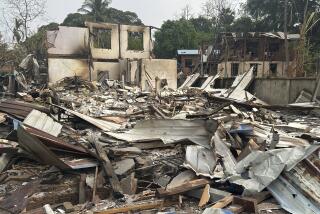U.N. Force Makes Gains in Securing East Timor
- Share via
DILI, East Timor — United Nations peacekeepers extended their presence into the troubled western region of East Timor on Friday in a effort to rid the area of the armed militias that have wrought havoc for the past month.
The peacekeeping force sent 700 soldiers into East Timor’s wild west, where the instability has continued in part because the area abuts the Indonesian province of West Timor, which militias have used as a base.
Since the first elements of the Australian-led force arrived in East Timor on Sept. 20, the peacekeepers have moved slower to restore order than many expected. This reflects the delicacy of working alongside a gradually shrinking number of Indonesian soldiers and the initial small size of the multinational force in East Timor, which is about the size of Vermont.
But the U.N. force continues to gain strength; it now includes about 5,000 soldiers and eventually will have about 7,500. As more soldiers pour in daily from Australia, New Zealand, Malaysia and the Philippines, the force is starting to take on more ambitious targets and move against militia strongholds.
This campaign, dubbed Operation Lavarack after a famed Australian soldier who served in World War II, involves the use of air, land and sea forces, said Major Mark Tanzer, including Black Hawk helicopters, navy landing craft and armored vehicles.
U.N. spokesman Col. Mark Kelly on Friday said that, despite the push into the western region, the peacekeepers will not cross into West Timor no matter how much they are provoked. Kelly refused to say what percentage of East Timor the forces now consider secure.
Indonesia took East Timor by force in 1975. In the subsequent 24 years, the Indonesian government struggled to consolidate its grip with a strong military force. When East Timorese voted overwhelmingly Aug. 30 to secede, anti-independence militias backed by Indonesian troops went on a rampage, burning, looting and killing their way across the territory.
U.N. forces on Friday reported the seizure of a large cache of weapons, including two truckloads of heavy caliber ammunition, rounds for machine guns, rocket launchers, handguns and detonators.
And at the United Nations, Ian Martin, the world body’s special representative for East Timor, told the Security Council that five structures in this territorial capital were torched Friday and that security remains a problem.
“It just points out that even [though] Dili is probably the most secure of any of the towns where the multinational force has deployed, it is still not 100%,” said Fred Eckhard, spokesman for U.N. Secretary-General Kofi Annan.
That said, this territorial capital is growing safer by the day. While heavy armored vehicles still rumble through Dili’s streets on an hourly basis, their turrets and machine guns at the ready, it’s been several days since gunfire has been heard.
With word that the city appeared relatively free of militias, an estimated 60,000 people returned Thursday from hiding in the mountains, straining the city’s damaged infrastructure.
Many of the recently arrived are camped out in the city’s stadium, which has seen a few near-riots when known militia members arrived and tried to blend in. They were taken away by Australian forces for questioning.
Meanwhile, British officers released details Friday on the most dramatic campaign of the 12-day U.N. peacekeeping effort.
While accompanying a humanitarian convoy Thursday to the town of Los Palos, 20 miles east of Baukau, soldiers from the Royal Gurkha Rifles were told by a local Catholic priest that relatively few refugees were in town to accept the food because they so feared the anti-independence militias.
Further investigation pointed to a militia stronghold in a nearby port town, Com, on East Timor’s eastern tip. The Gurkhas decided to take a 40-minute side trip by road.
“We were astounded by the sight of 3,000 civilians” in Com being held against their will by a small force of about 10 armed militia members in an enclosed area by the quay, said British Maj. Tim Warrington, who was in charge of the convoy’s Gurkha troops.
At the sight of the Gurkhas, the militias fled into the jungle. The Gurkhas brought the refugees out of Com, with help from members of East Timor’s pro-independence guerrilla movement, and also sought the surrender of the militia fighters.
At 4 a.m. Friday, the militia members had a fight among themselves and broke into two groups, one in favor of surrender and the other opposed.
At dawn, the Gurkhas closed in and captured four unarmed militia members. According to the local Catholic priest, the remaining militia members were still considering later in the day whether to surrender, fearful because their identity is so well known by local residents.
*
Times staff writer John J. Goldman at the United Nations contributed to this report.
More to Read
Sign up for Essential California
The most important California stories and recommendations in your inbox every morning.
You may occasionally receive promotional content from the Los Angeles Times.













